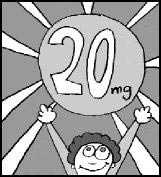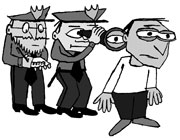SOMETIMES, even with a national story, I can know with certainty that public figures or media reports are full of it because my personal experience flatly contradicts what the public is being told.
Like last week, when the head of the U.S. Drug Enforcement Administration warned a House subcommittee and the American public about the widespread abuse of the prescription painkiller OxyContin.
OxyContin is the trade name for a time-release version of oxycodone, a pain suppressant on the market since 1995. The time-release version is ideal for treating chronic pain. Because it works so well, its popularity has soared; the maker, Purdue Pharma, recorded over $1 billion in Oxy sales in 2000.
But over the last year, a steadily growing avalanche of official warnings and media scare stories have been exaggerating the hazards—and, from a druggie’s standpoint, desirability—of OxyContin. Two early incidents of OxyContin abuse, in Kentucky and Virginia, were inflated for political purposes by local officials, then seized upon by media outlets looking for the Next Big Drug. The alarm gained a life of its own, repeated and embellished so many times that it has gained the aura of truth. And so, reports of DEA head Asa Hutchinson’s testimony last week described OxyContin’s “heroinlike high” (a phrase common in articles on the drug) and that it was “a likely factor” in 296 overdose deaths in two years. Suggested responses to this manufactured crisis have ranged from federal tracking of prescription rates among doctors and geographic areas to calls for pulling the drug off the market entirely.
I don’t generally defend drug companies, but Hutchinson, in ripping Purdue, showed the worst kind of fraudulent political opportunism. The “abuse” in this case is two decades’ worth of War on Drugs mentality, clouding fact. So let’s start with fact.
OxyContin does not produce a “heroinlike” high. If it did, I couldn’t write this column. I’ve been taking the drug every few hours for the last seven years because of persistent pain stemming from an operation that saved my life—another person’s kidney and pancreas were transplanted into my body. The pain hasn’t responded to any other treatment. I couldn’t function from day to day without oxycodone. And for many, many people with cancer, AIDS, and other serious ailments, it’s the difference between a relatively normal life and pure hell.
When I first took it, I got a little light-headed and chatty. It can be pleasant, though not hugely so; were it freely available, I certainly wouldn’t go out of my way to take it just for its “high.” And after taking it routinely for a while, the high disappears entirely.
Perhaps I just don’t react much to drugs. But even when I’ve accidentally taken more than my normal dose, OxyContin has not been a remarkably fun drug, and if you take way, way too much, you just get nauseated and shaky and start vomiting. Or, if you take a whole bunch of it, you die. The only difference I can tell at the moment between being on it and having missed my dose is that my leg doesn’t hurt much. But I can well imagine someone not familiar with the drug expecting a “heroinlike high,” then overdosing because they take some and nothing happens, so they take a whole lot more.
And yes, OxyContin is a narcotic, and I am “addicted” to it, in the sense that if I don’t take it I’d get nasty withdrawal symptoms. In terms of whether my body would be unhappy without it, I’m also “addicted” to a number of other prescribed drugs and to food, water, oxygen, and my sweetie. Addiction is an overrated concept.
OxyContin is invaluable for me and many other people. If you figure, conservatively, that $1 billion in sales means a million people took OxyContin in 2000 (spending $1,000 each on it), that’s about one overdose death for every 3,000 immeasurably improved lives.
But . . . many of those deaths came when OxyContin was combined with other drugs, legal or not. It wasn’t necessarily the primary cause or even used incorrectly. Moreover, we don’t know how many of those deaths were suicides— quite possible for people facing permanent chronic pain. And if OxyContin abuse is so epidemic, considering that it’s addictive, where are all the Oxy-related crimes? Junkies stealing to get their fix? Gangs with organized sales networks? No such crime wave is reported anywhere, despite nearly a year of media hype that has surely raised the curiosity of junkies everywhere.
An invaluable drug is being portrayed as a menace to society, with a handful of tragedies being expropriated as proof. It’s the sort of fiction that has used a very real problem—drug abuse—to justify a decades-long grab for government power—the War on Drugs. The War on Drugs is dead; it hasn’t worked, and with new laboratory-designed drugs, it will soon be completely unenforceable. We should instead be teaching people how to use mind-altering substances responsibly. (We could start with alcohol.) Meanwhile, keep your hands off my OxyContin. It’s time for my next pill.







